
HOME
INTRO
SYMBOLS
ALMANAC
ECONOMY
GEOGRAPHY
STATE MAPS
PEOPLE
FORUM
NEWS
COOL SCHOOLS
STATE QUIZ
STATE LINKS
BOOK STORE
MARKETPLACE
NETSTATE.STORE
NETSTATE.MALL
GUESTBOOK
CONTACT US


Vermont State Rocks

The outer stonework is Vermont Imperial Danby marble
Jefferson Memorial pictures and prints
House Bill No. 678, cosponsored by Representatives Michael Obuchowski and Sean Campbell, called for the adoption of an official state gem (grossular garnet), and official state mineral (talc), and an official state rock (marble).
The proposal was made by Sue Hadden and sanctioned by Vermont mineralogical societies, clubs, geologists (including the recently retired State Geologist Charles Ratté), geology teachers, and industrialists within the mining industry.
"Just as the state has honored the hermit thrush, red clover, and sugar maple, it should honor its unique geologic heritage by naming a state gem, rock, and mineral and join the 95% of the other 50 states to have done so."
(Hadden 29)
Marble was considered a good choice for the official rock because;
- It was found throughout the state;
- and Vermont's white marble brought world-wide attention to the state.
Indeed, Vermont's beautiful white marble, of the Imperial vein in Danby, can be found far and wide in such as the Jefferson Memorial and Old Senate Office Building in Washington, D.C., the New York City Public Library, and the Chiang Kai-Shek Memorial in Taiwan.
Other ideas for an official state rock had been considered. In particular, slate and granite were important to the Vermont economy. But each, in turn, was dismissed.
Slate wasn't common throughout Vermont and the Vermont Structural Slate Company was even importing some of its slate from out of state. These two considerations were thought to make it a less than ideal candidate for Vermont's official state rock.
Granite had already been adopted by five other states, including Vermont's next-door neighbors, New Hampshire and Massachusetts. New Hampshire was even nicknamed "The Granite State." Granite also seemed an unsatisfactory choice.
Marble it was! At least that's what was written into the bill presented to the legislature.
But, as you can see by the title of this page, marble did not end up being the only state rock of Vermont.
Yes, the slate and granite interests in the state made a fuss.
When Governor Howard Dean signed House Bill No. 678, Vermont gained an official state gem, an official state mineral, and three official rocks.

Vermont State Rock: Marble
Photograph: Vermont Quarries Corp.
Vermont's complex geology has led to the development of a diverse and economically healthy minerals industry which began in Vermont over 200 years ago. Because three of Vermont's rocks are equally important to the state's economy, all three - granite, marble and slate - were formally recognized as State Rocks by Act No. 221 of 1992.
Marble, a metamorphic rock composed of the mineral calcite, can generally be found in southwestern Vermont. The marble quarry in Danby is the world's largest underground quarry, covering twenty acres. Vermont marble ranges in color from pure white to black. It has been used in building Radio City Music Hall, the National Art Gallery, the Jefferson Memorial and the Vermont State Capitol.
------- from Office of the Secretary of State,
Vermont Legislative Directory and State Manual,
Biennial Session, 1993-1994, p. 23.

Vermont State Rock: Slate
Cedar Point quarry, on Lake Bomoseen, Castleton
Slate is a metamorphic rock found in southwestern Vermont. It is formed by the compaction and heating of clay, silt or mud. Vermont slate varies in color from red, green, black and purple. Because it splits into thin slabs, slate is used for roofing shingles, sidewalks and floor tiles.
------- from Office of the Secretary of State,
Vermont Legislative Directory and State Manual,
Biennial Session, 1993-1994, p. 23.

Vermont State Rock: Granite
Photograph: Barry Gray Granite - Rock of Ages Corporation
Granite is an igneous rock found along the entire length of the eastern part of the state. It is mainly composed of feldspar, quartz and mica. The granite from Barre is world-famous, and the Westmore-Morse Quarry in Barre is the world's largest monumental granite quarry. Vermont granite is exported to many states and countries for use as building stone and is prominent in the Vermont State Capitol.
------- from Office of the Secretary of State,
Vermont Legislative Directory and State Manual,
Biennial Session, 1993-1994, p. 23.
Vermont Law
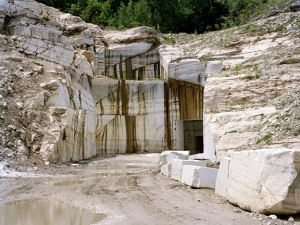
Danby Marble Quarry
Photograph: Vermont Quarries Corp.
The following information was excerpted from the Vermont Statutes Annotated, Title 1, Chapter 11, Section 507.
TITLE ONE. GENERAL PROVISIONS
CHAPTER 11. FLAG, INSIGNIA, SEAL, ETC.
1 V.S.A. § 507 (2012)
§ 507. State rocks
The state rocks shall be marble, granite and slate.
HISTORY: Added 1991, No. 221 (Adj. Sess), § 2, eff. May 28, 1992.
Sources...
"Vermont Statutes Annotated." LexisNexis, a division of Reed Elsevier Inc.. LexisNexis, a division of Reed Elsevier Inc., n.d. Web. 22 Feb 2012.
"Vermont Emblems, Facts and Figures." Vermont Department of Libraries. State of Vermont, n.d. Web. 22 Feb 2012.
Shearer, Benjamin F. and Barbara S. State Names, Seals, Flags and Symbols: A Historical Guide Third Edition, Revised and Expanded. Westport, Conn: Greenwood Press, 3 Sub edition, 2001.
Additional Information
Welcome to Industrial Minerals of Vermont: 200 Years and Going Strong: by Diane Conrad and Diane Vanacek (early 1990s), with portions updated in 2005 by Sarah King.
The Commercial Marbles of Western Vermont :
U.S. Geological Survey publication. "The Commercial Marbles of Western Vermont"; 1912; B; 521; Dale, T. Nelson
:
U.S. Geological Survey publication. "The Commercial Marbles of Western Vermont"; 1912; B; 521; Dale, T. Nelson
The Granites of Vermont :
U.S. Geological Survey publication. "The Granites of Vermont"; 1909; B; 404; Dale, T. Nelson
:
U.S. Geological Survey publication. "The Granites of Vermont"; 1909; B; 404; Dale, T. Nelson
State rocks: Complete list of official state rocks from NETSTATE.COM.
More symbols & emblems: Complete list of official Vermont state symbols from NETSTATE.COM.
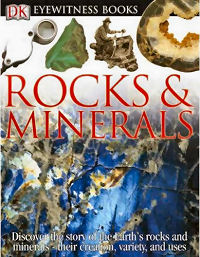
Eyewitness Books: Rocks & Minerals
Eyewitness Books: Rocks & Minerals, by Chris Pellant, R.F. Symes 72 pages. DK CHILDREN (August 2, 2004) Reading level: Ages 9-12. Here is a spectacular and informative guide to the amazing world beneath our feet. Stunning color photographs of rocks, fossils, minerals, precious metals, crystals, jewels and gemstones give the reader a unique "eyewitness" insight into the evolution and composition of the Earth. See rocks that have come from outer space, stalactites as old as dinosaurs, the strange and beautiful shapes of natural crystals and priceless nuggets of gold, silver and platinum. Learn what the Earth is made of - and how its rocks were formed, how early humans made the first flint tools and how diamonds and precious stones are cut, polished, and made into jewelry. Discover how prehistoric animals are preserved today as fossils, how volcanoes work, how rocks are formed from molten lava, how minerals and metals are mined and how pebbles on the seashore are worn down into sand, and much, much more!
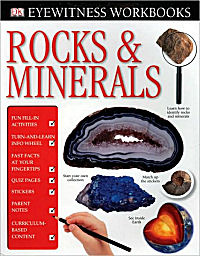
Eywitness Workbook: Rocks & Minerals
Eyewitness Workbooks: Rocks & Minerals, 48 pages. DK CHILDREN; Workbook edition (June 16, 2008) Reading level: Ages 9-12. Perfect for getting ahead at school or just stimulating children's interest, this groundbreaking series of workbooks leaves the competition in the dust, with exciting subjects, 48 full-color pages, a turn-and-learn info wheel, and special carrying folders. Never before have there been workbooks with so many opportunities for fun and interactive learning!
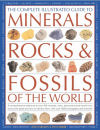
The Complete Illustrated Guide to Minerals, Rocks & Fossils of the World, by John Farndon and Steve Parker. 512 pages. Publisher: Lorenz Books, an imprint of Anness Publishing (June 16, 2010) A comprehensive reference to over 700 minerals, rocks, plants and animal fossils from around the globe and how to identify them, with over 2000 photographs and artworks.
This stunning and expert book provides a complete reference for anyone interested in the earth sciences. Each section of the book starts with an informative introduction explaining how the phenomena have formed and their major defining characteristics, the habitats in which they are typically found and where the best examples are located around the world.
How-to techniques for the amateur geologist and palaeontologist show how to extract samples safely, and how to identify, date and classify them. There are step-by-step instructions on simple home testing methods to gauge rock and mineral colour, hardness, cleavage, lustre, tenacity and transparency. There is practical guidance on the best ways to clean, preserve and then display the specimens to build a superb collection of your own.
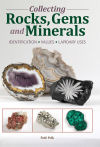
Collecting Rocks,
Gems & Minerals
Patti Polk
Collecting Rocks, Gems & Minerals, by Patti Polk. 272 pages. Publisher: Krause Publications (May 13, 2010) Collecting Rocks, Gems and Minerals takes you from having a casual interest in rocks to being a true collector, and it serves as the only book of its kind to have values for these beautiful offerings from nature.
The easy-to-use, and durable design of this book makes it the perfect guide to use out in the field, and it:
- Covers both lapidary and mineral display materials
- Includes organics such as amber, bone, coral, pearl and shell
- Lists chemical group, system, hardness, opacity, fracture, specific gravity and more
- Provides values and tips for locating, buying and collecting
- Contains 650+ full-color photos
Peterson First Guides: Rocks and Minerals, by Frederick H. Pough. 128 pages. Houghton Mifflin Harcourt (August 15, 1998) Written and designed for the beginner, this book describes and illustrates the most common and interesting rocks and minerals, from simple sandstone to exotic gems. Illustrated with dozens of beautiful color photographs, it tells how these rocks and minerals formed and how to identify them--and includes tips on collecting.
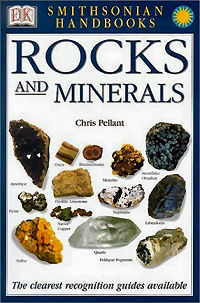
Rocks and Minerals
by Chris Pellant
Rocks & Minerals, by Dougal Dixon. 160 pages. Fireside (August 15, 1992) Beginning with a history of the earth's formation and development, this book explores the substances that compose the planet, movements within the earth, the surface effects of weather and water, and underground landscapes. It shows you how to search for, identify, and extract samples of various rocks and minerals, and for each rock and mineral type there is a brief mineralogy and explanation of its locations. There are also sections on mapping, preparing, and curating specimens, and geological sites on the six continents. Packed with more than 200 full-color illustrations, this comprehensive guide is the essential practical companion for natural science enthusiasts everywhere.
Smithsonian Handbooks: Rocks and Minerals, by Chris Pellant. 256 pages. DK ADULT; 1st edition (September 1, 2002) The Smithsonian Handbook of Rocks and Minerals combines 600 vivid full--color photos with descriptions of more than 500 specimens. This authoritative and systematic photographic approach, with words never separated from pictures, marks a new generation of identification guides. Each entry combines a precise description with annotated photographs to highlight the chief characteristics of the rock or mineral and distinguishing features.
Field Guide to North American Rocks and Minerals, National Audubon Society. 856 pages. Knopf; 1st Edition (5th Printing) edition (May 12, 1979) Perfect for mountain climbers and hikers, this valuable reference covers more rocks and minerals in North America than any other available guide. 794 full-color photographs depict all the important rocks, gems, and minerals -- in many variations of color and crystal form -- and the natural environments in which they occur; written descriptions provide information on field marks, similar rocks and minerals, environment, areas of occurrence, and derivation of names. Includes a guide to mineral collecting and a list of rock-forming minerals

